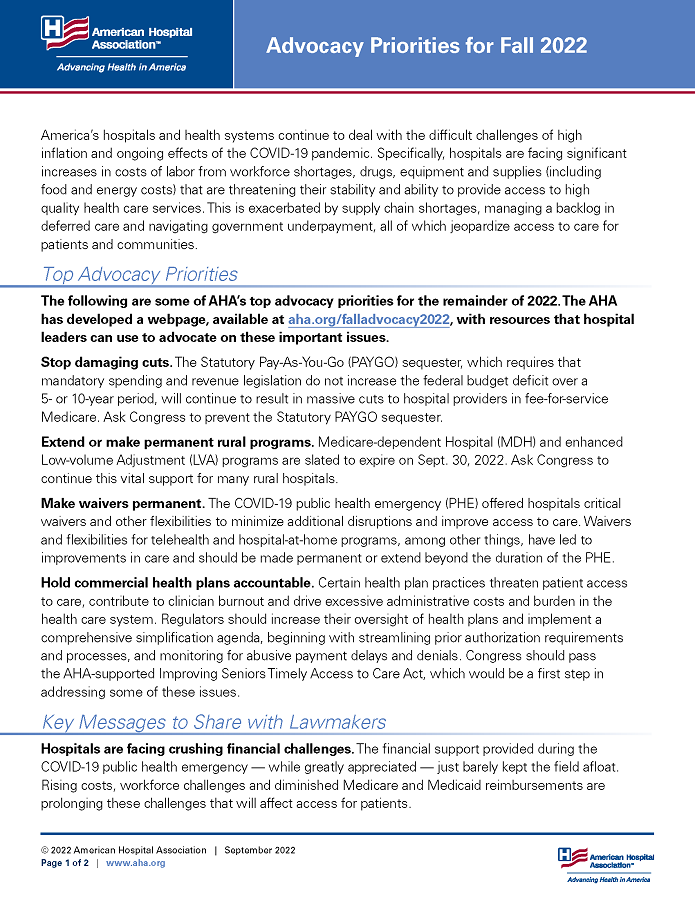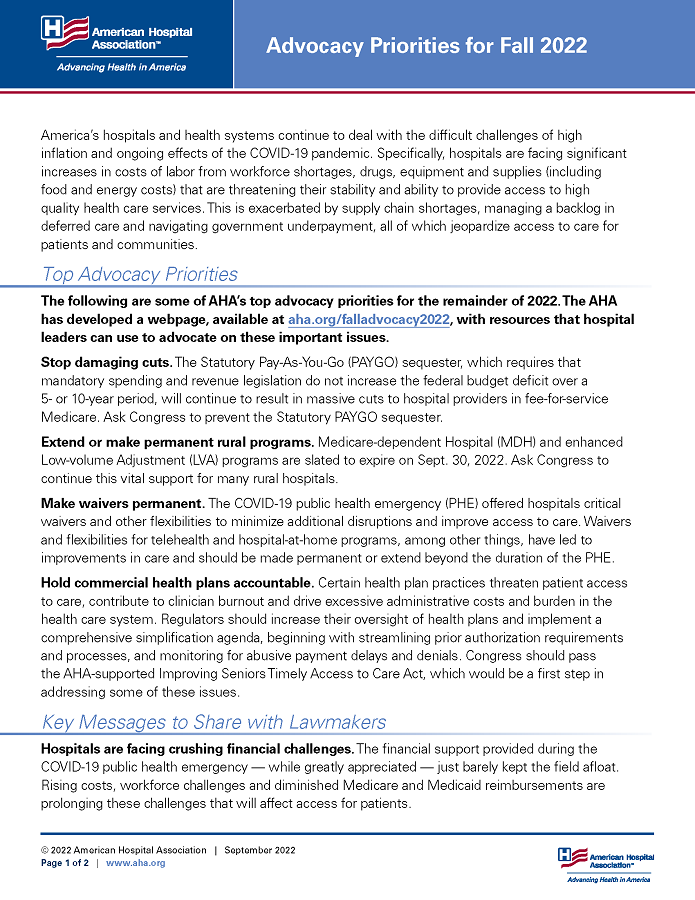

Fact Sheet: Advocacy Priorities for Fall 2022
America’s hospitals and health systems continue to deal with the difficult challenges of high inflation and ongoing effects of the COVID-19 pandemic. Specifically, hospitals are facing significant increases in costs of labor from workforce shortages, drugs, equipment and supplies (including food and energy costs) that are threatening their stability and ability to provide access to high quality health care services. This is exacerbated by supply chain shortages, managing a backlog in deferred care and navigating government underpayment, all of which jeopardize access to care for patients and communities.
Top Advocacy Priorities
The following are some of AHA’s top advocacy priorities for the remainder of 2022. The AHA has developed a webpage, available at aha.org/falladvocacy2022, with resources that hospital leaders can use to advocate on these important issues.
Stop Damaging Cuts
The Statutory Pay-As-You-Go (PAYGO) sequester, which requires that mandatory spending and revenue legislation do not increase the federal budget deficit over a 5- or 10-year period, will continue to result in massive cuts to hospital providers in fee-for-service Medicare. Ask Congress to prevent the Statutory PAYGO sequester.
Extend or Make Permanent Rural Programs
Medicare-dependent Hospital (MDH) and enhanced Low-volume Adjustment (LVA) programs are slated to expire on Sept. 30, 2022. Ask Congress to continue this vital support for many rural hospitals.
Make Waivers Permanent
The COVID-19 public health emergency (PHE) offered hospitals critical waivers and other flexibilities to minimize additional disruptions and improve access to care. Waivers and flexibilities for telehealth and hospital-at-home programs, among other things, have led to improvements in care and should be made permanent or extend beyond the duration of the PHE.
Hold Commercial Health Plans Accountable
Certain health plan practices threaten patient access to care, contribute to clinician burnout and drive excessive administrative costs and burden in the health care system. Regulators should increase their oversight of health plans and implement a comprehensive simplification agenda, beginning with streamlining prior authorization requirements and processes, and monitoring for abusive payment delays and denials. Congress should pass the AHA-supported Improving Seniors Timely Access to Care Act, which would be a first step in addressing some of these issues.
Key Messages to Share with Lawmakers
Hospitals are facing crushing financial challenges. The financial support provided during the COVID-19 public health emergency — while greatly appreciated — just barely kept the field afloat. Rising costs, workforce challenges and diminished Medicare and Medicaid reimbursements are prolonging these challenges that will affect access for patients.
A majority of payments to hospitals and health systems are dependent on Medicare and Medicaid — fixed costs that don’t allow hospitals to absorb or deflect the impact of the historic inflation levels. Ninety-four percent of hospitals have 50% or more of their inpatient days paid by Medicare or Medicaid and more than three quarters of hospitals have 67% or more Medicare or Medicaid inpatient days — meaning inflation is having a devastating effect on hospitals’ abilities to keep the lights on.
Hospitals and health systems are navigating unprecedented increased expenses from supply chain disruptions, workforce shortages, and labor and drug costs. Even before the pandemic, labor costs — including recruitment, retention, benefits, incentives and training — accounted for more than 50% of hospitals’ total expenses. By the end of 2021, hospital labor expenses per patient were 19.1% higher than pre-pandemic levels.
Explain the real consequences to people should further payment reductions occur, including jeopardizing your organization’s ability to provide care. Financial instability will threaten access to care for your patients and communities. Without critical lifelines from Congress, hard choices will need to be made with regards to services, staffing and patients’ access.


